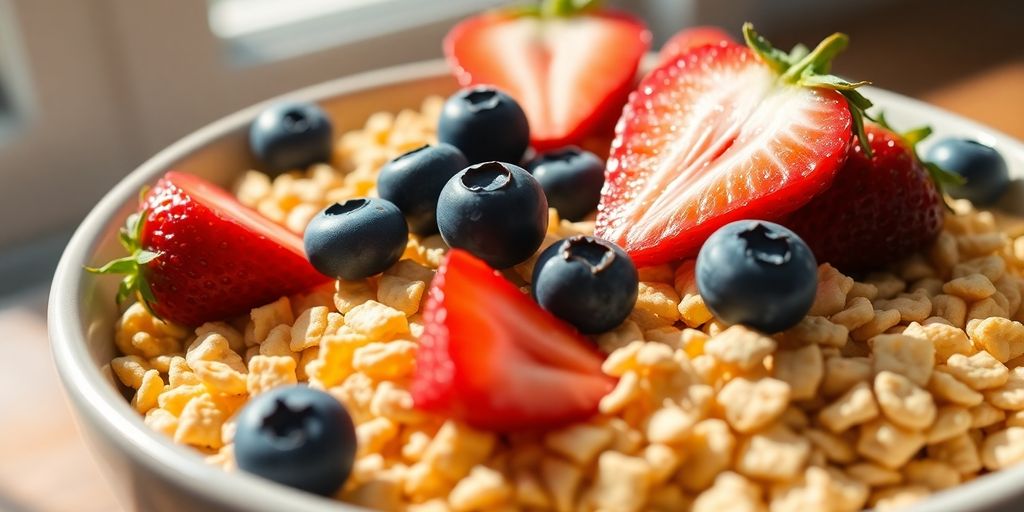Struggling to find a decent breakfast cereal in Australia that’s actually good for you? It’s a minefield out there, isn’t it? With so many options screaming about their health benefits, it’s easy to get lost. But don’t worry, we’re cutting through the noise to help you find the highest fibre cereal australia has to offer, making your mornings a whole lot easier and healthier.
Key Takeaways
- When choosing a cereal, aim for options with over 10g of fibre per 100g to help meet your daily intake.
- Look for cereals that clearly state ‘whole grains’ on the packaging, ideally making up 50% or more of the product.
- Be mindful of portion sizes; a small bowl or teacup can be a good way to manage intake.
- Adding seeds or nuts like pepitas, sunflower seeds, or flaxseeds is a simple way to boost fibre and healthy fats.
- While some cereals are naturally sweetened with fruit like sultanas, always check the sugar content and try to opt for lower amounts.
Discover Australia’s Highest Fibre Cereal Options

Navigating the cereal aisle in Australia can feel like a mission, especially when you’re trying to boost your fibre intake. With so many options, it’s easy to get lost in the colourful boxes and catchy slogans. But don’t worry, we’ve done some of the legwork for you. Finding a breakfast cereal that’s both delicious and packed with fibre is totally achievable. Let’s look at some of the top contenders that are readily available.
Kellogg’s Guardian: A Fibre-Rich Choice
Kellogg’s Guardian is often mentioned as a solid choice for fibre. It’s a pretty straightforward cereal, not overly sweet, which is a plus if you’re trying to cut down on sugar. Many people find that once their taste buds adjust away from super-sweet options, they can really appreciate the subtle sweetness in cereals like this. It’s also known to score well on health rating systems, which is always a good sign.
Kellogg’s All-Bran: A Long-Standing Favourite
Whether you prefer the flakes or the original bran, Kellogg’s All-Bran is a classic for a reason. It’s consistently high in fibre, which is great for keeping things moving smoothly. Some people even like to warm it up like porridge in the cooler months, adding a sprinkle of cinnamon and seeds for extra flavour and nutrients. It’s a reliable option if you’re looking for a fibre boost.
Goodness Superfoods: Boosting Your Daily Fibre Intake
This Australian brand offers cereals that are genuinely high in fibre. Their ‘Protein 1st’ option is a popular pick. While the high fibre content is fantastic for most, it’s worth noting that some people might experience a bit of digestive adjustment initially. If you’re looking to significantly increase your fibre, these are definitely worth considering to see how your body responds. They’re a great way to get more fibre into your diet, and you can find them at most major supermarkets.
Top Picks for High Fibre Cereals Down Under

When you’re scanning the cereal aisle, it’s easy to get overwhelmed. So many boxes, so many claims! But if you’re after a fibre boost, a few stand out. Let’s look at some top picks that are readily available here in Australia.
Uncle Toby’s Shredded Wheat: Simple and High Fibre
This one is pretty straightforward, isn’t it? Just shredded wheat, really. It’s got a good amount of fibre and doesn’t pack a lot of sugar, which is a win. It even scores a perfect 5 stars on the Health Star Rating system. While I haven’t personally tried it, it certainly looks the part for a healthy start to the day.
Sanitarium Weet-Bix Hi-Bran: A Fortified Option
Think of this as the super-powered version of the classic Weet-Bix. It’s a solid choice for getting fibre into your diet. The good thing is, the sugar and salt content is pretty minimal, mostly coming from what you add yourself. To make it even better, you could toss in some seeds for extra fibre and protein, or pair it with some fresh fruit like berries or a banana.
Vogel’s Ultra Bran and Soy: A Lesser-Known Gem
This brand might not be as common on everyone’s shelves, but it’s definitely worth a look if you’re prioritising fibre and keeping sugar low. It’s not flashy, but the ingredients are simple, it’s got a low GI, and the taste is quite pleasant. It’s a good option if you’re looking for something a bit different but still really healthy. Finding cereals with whole grains as the primary ingredient is always a good sign.
Remember, adding a handful of seeds like pepitas or sunflower seeds, or even some nuts, can really boost the fibre and healthy fat content of any cereal.
Understanding Cereal Nutrition for Australian Consumers
When you’re standing in the cereal aisle, it can feel a bit overwhelming, right? So many boxes, so many claims. Let’s break down what actually matters when you’re picking out your breakfast cereal here in Australia.
The Importance of Fibre Content
Fibre is a big deal for keeping things running smoothly and feeling full. It helps with digestion and can even help manage blood sugar levels. When you’re looking at the nutrition panel, aim for cereals that list fibre pretty high up. It’s not just about the total amount, but also where it comes from – whole grains are usually the best source. Think about it, you want something that keeps you going until lunch, not something that leaves you hungry an hour later.
Decoding Whole Grains in Cereals
So, what exactly are ‘whole grains’? Basically, it means the grain hasn’t been messed with too much. It still has all its good bits: the bran, the germ, and the endosperm. Cereals that use whole grains as their main ingredient are generally a better bet. You’ll often see terms like ‘whole wheat’, ‘rolled oats’, or ‘brown rice’ listed first on the ingredients list. This is a good sign. For example, Uncle Toby’s Oat Crisp Honey Macadamia uses ingredients like rolled oats, which are a great source of fibre.
Navigating Sugar Content in Breakfast Choices
This is where things can get tricky. Many cereals, even ones that sound healthy, can be loaded with added sugar. You’ll see it listed under different names too, like glucose syrup, malt extract, or even just ‘sugar’. It’s really important to check the sugar content per 100g on the nutrition information panel. Some cereals can have over 30% sugar, which is a lot for something you eat first thing in the morning. It’s worth comparing a few different brands to see which ones keep the sugar low.
The marketing on the front of the box can be misleading. Always turn the box around and check the ingredients list and the nutrition panel. That’s where the real story is.
Making Healthier Choices in the Cereal Aisle
Choosing a breakfast cereal can feel like a minefield, can’t it? All those colourful boxes and bold claims on the front can be pretty misleading. It’s really important to look past the marketing hype and get down to the nitty-gritty of what’s actually in the box. The good news is, once you know what to look for, it’s not that hard to pick a winner.
Beyond the Marketing: Reading Nutritional Panels
Forget what the front of the box shouts about being ‘packed with vitamins’ or ‘a great start to the day’. The real story is told on the nutritional information panel. This is where you’ll find the facts, and it’s legally required to be accurate. So, what should you be scanning for?
- Fibre: Aim for cereals with at least 10g of fibre per 100g. This is your golden ticket to a satisfying breakfast that keeps you going.
- Whole Grains: Look for ‘whole grain’ listed as the first ingredient, and ideally, the cereal should be made up of 50% or more whole grains. This means you’re getting the good stuff, not just refined flour.
- Sugar: This is a big one. Try to find cereals with less than 10g of sugar per 100g. If there’s fruit in the cereal, like sultanas, that’s fine, but watch out for added sugars listed high up in the ingredients.
The food industry is pretty clever at making less healthy options seem appealing. Don’t be fooled by claims of added vitamins if the cereal is also loaded with sugar and low in fibre. Focus on the core nutritional components.
The Role of Health Star Ratings
The Health Star Rating system is a handy tool designed to make choosing healthier foods easier. It gives packaged foods a rating from half a star to five stars, with more stars indicating a healthier choice. When you’re in the cereal aisle, give those boxes a quick glance for their Health Star Rating. A higher rating generally means the cereal is better for you, taking into account factors like fibre, sugar, sodium, and saturated fat. It’s a quick way to compare products side-by-side.
Tips for Boosting Fibre with Seeds and Nuts
Even if you find a decent high-fibre cereal, you can always give it an extra boost. Adding a tablespoon or two of seeds like flaxseeds, chia seeds, or sunflower seeds can significantly increase the fibre content of your breakfast. A small handful of chopped nuts also adds fibre, healthy fats, and a satisfying crunch. It’s a simple way to make a good cereal even better and ensure you’re getting closer to your daily fibre needs, which are important for overall health and can help with cholesterol levels Australian guidelines.
Exploring High Fibre Cereal Brands in Australia
When you’re scanning the cereal aisle, it’s easy to get a bit overwhelmed. There are so many options, and they all seem to promise a healthy start to your day. But let’s get real, not all cereals are created equal, especially when it comes to fibre. We’re going to look at a few brands that consistently show up as good choices for getting more fibre into your diet.
Uncle Toby’s Bran Plus: A Worthy Alternative
Uncle Toby’s Bran Plus is often seen as a solid contender if you’re a fan of bran-based cereals. It’s designed to give you a good dose of fibre, which is great for keeping things moving smoothly. It’s a bit like a more accessible version of other bran cereals, making it a go-to for many Aussies looking for that fibre boost without too much fuss. It’s a good idea to compare it with other bran options to see which texture and taste you prefer.
Woolworths Homebrand Processed Bran: An Affordable Option
Now, the name might not exactly scream ‘gourmet’, but Woolworths Homebrand Processed Bran is definitely worth a look if you’re on a budget. It packs a serious fibre punch, similar to some of the pricier brands, and generally doesn’t load up on sugar. While I haven’t personally tried this one, the nutritional profile suggests it’s a smart buy for anyone wanting to increase their fibre intake without breaking the bank. It’s a good example of how you don’t always need to spend a lot to get a healthy staple.
Kellogg’s Sultana Bran Original: Naturally Sweetened
Kellogg’s Sultana Bran Original is a bit of a classic, isn’t it? While it does have a bit more sugar than some of the plain bran options, the sweetness comes from the sultanas themselves, which is a nice touch. If you find plain cereals a bit bland, or if you’re trying to get kids to eat something with more fibre, this is a decent choice. Just be sure to grab the ‘Original’ version, as the other variations like buds or clusters can sometimes have added sugars or less fibre. It’s a good way to get a bit of natural sweetness in your morning bowl.
Wrapping Up Your High-Fibre Breakfast Quest
So, there you have it. Navigating the cereal aisle doesn’t have to be a headache anymore. We’ve looked at some top-notch options that pack a serious fibre punch, helping you start your day feeling fuller for longer. Remember to keep an eye on those fibre and whole grain counts, and don’t be afraid to add a few seeds or nuts to really boost the goodness. Making a healthier breakfast choice is totally doable, and your body will thank you for it.
Frequently Asked Questions
How much fibre should I look for in a cereal?
To get enough fibre each day, aim for cereals with more than 10 grams of fibre for every 100 grams of cereal. This helps you reach the recommended 25-30 grams of fibre daily, which many Aussies miss out on.
What does ‘whole grain’ mean on a cereal box?
Whole grains are best! Look for cereals that say they have at least 50% whole grains on the front. Cereals made with more whole grains are generally healthier than those that are more processed.
How much sugar is too much in cereal?
It’s best to keep added sugar low. Aim for cereals with less than 10-15 grams of sugar per 100 grams. It’s even better if the sweetness comes from natural sources like fruit, rather than added sugars.
What is the Health Star Rating on cereals?
The Health Star Rating is a quick guide. Cereals with more stars are generally healthier. It looks at good stuff like fibre and protein, and bad stuff like sugar and salt.
How can I add more fibre to my cereal?
You can boost your cereal’s fibre by adding seeds like sunflower or pumpkin seeds, or some nuts. This also adds protein and healthy fats to your breakfast.
How do I know if a cereal is truly healthy?
While some cereals are marketed as healthy, always check the nutrition panel. Look for high fibre and whole grains, and low sugar. Don’t just trust the front of the box!





